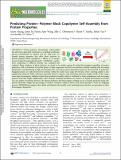| dc.contributor.author | Huang, Aaron | |
| dc.contributor.author | Paloni, Justin Michael | |
| dc.contributor.author | Wang, Amy | |
| dc.contributor.author | Obermeyer, Allie C | |
| dc.contributor.author | Sureka, Hursh Vardhan | |
| dc.contributor.author | Yao, Helen | |
| dc.contributor.author | Olsen, Bradley D | |
| dc.date.accessioned | 2019-09-25T20:30:53Z | |
| dc.date.available | 2019-09-25T20:30:53Z | |
| dc.date.issued | 2019-09 | |
| dc.date.submitted | 2019-06 | |
| dc.identifier.issn | 1525-7797 | |
| dc.identifier.issn | 1526-4602 | |
| dc.identifier.uri | https://hdl.handle.net/1721.1/122285 | |
| dc.description.abstract | Protein-polymer bioconjugate self-assembly has attracted a great deal of attention as a method to fabricate protein nanomaterials in solution and the solid state. To identify protein properties that affect phase behavior in protein-polymer block copolymers, a library of 15 unique protein-b-poly(N-isopropylacrylamide) (PNIPAM) copolymers comprising 11 different proteins was compiled and analyzed. Many attributes of phase behavior are found to be similar among all studied bioconjugates regardless of protein properties, such as formation of micellar phases at high temperature and low concentration, lamellar ordering with increasing temperature, and disordering at high concentration, but several key protein-dependent trends are also observed. In particular, hexagonal phases are only observed for proteins within the molar mass range 20-36 kDa, where ordering quality is also significantly enhanced. While ordering is generally found to improve with increasing molecular weight outside of this range, most large bioconjugates exhibited weaker than predicted assembly, which is attributed to chain entanglement with increasing polymer molecular weight. Additionally, order-disorder transition boundaries are found to be largely uncorrelated to protein size and quality of ordering. However, the primary finding is that bioconjugate ordering can be accurately predicted using only protein molecular weight and percentage of residues contained within β sheets. This model provides a basis for designing protein-PNIPAM bioconjugates that exhibit well-defined self-assembly and a modeling framework that can generalize to other bioconjugate chemistries. | en_US |
| dc.description.sponsorship | United States. Department of Energy. Office of Basic Energy Sciences (Award DE-SC0007106) | en_US |
| dc.language.iso | en | |
| dc.publisher | American Chemical Society (ACS) | en_US |
| dc.relation.isversionof | http://dx.doi.org/10.1021/acs.biomac.9b00768 | en_US |
| dc.rights | Creative Commons Attribution-NonCommercial-NoDerivs License | en_US |
| dc.rights.uri | http://creativecommons.org/licenses/by-nc-nd/4.0/ | en_US |
| dc.source | ACS | en_US |
| dc.title | Predicting Protein–Polymer Block Copolymer Self-Assembly from Protein Properties | en_US |
| dc.type | Article | en_US |
| dc.identifier.citation | Huang, Aaron et al. "Predicting Protein–Polymer Block Copolymer Self-Assembly from Protein Properties." Biomacromolecules (September 2019): 9b000768 © 2019 American Chemical Society | en_US |
| dc.contributor.department | Massachusetts Institute of Technology. Department of Chemical Engineering | en_US |
| dc.relation.journal | Biomacromolecules | en_US |
| dc.eprint.version | Final published version | en_US |
| dc.type.uri | http://purl.org/eprint/type/JournalArticle | en_US |
| eprint.status | http://purl.org/eprint/status/PeerReviewed | en_US |
| dc.date.updated | 2019-09-20T14:14:47Z | |
| dspace.date.submission | 2019-09-20T14:14:50Z | |
